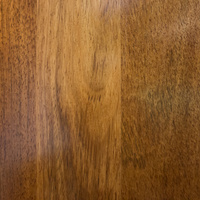Common name: Merbau
Other common names: Borneo teak, Ipil, Johnstone river teak, Kwila, Moluccan ironwood, Vesi
Description
Merbau is semi-evergreen timber and landscape tree native to the geographic region extending from Tanzania, through coastal India and Southeast Asia to Australia and the Pacific.
It may reach up to 35 m (115 ft) tall in closely spaced forests, with a straight, slender trunk clear of branches for about half its height and up to 1 m (3 ft) in diameter. Older trees grow buttresses or mangrove-like prop roots, depending on the site conditions.
On open sites, it is more typically 15 to 20 m (50 to 65 ft) tall and develops an upright trunk supporting a wide-spreading rounded crown. The bark is light brown or grey, smooth but with scattered flaking.
The leaves are compound, consisting of two or four glossy green, oval leaflets arranged in pairs.
The flowers are single-petaled, white changing to pink and have long red stamens. They are sweetly fragrant and bloom throughout the year or on and off in showy clusters arising at the branch ends. Fertilised flowers develop into flat, wide seedpods up to 10 cm (4 in) long, green when young, turning brown when mature.
Use
Merbau is commonly cultivated in seaside gardens and coastal landscapes for its showy and fragrant flowers and its tolerance to salty conditions, including soil salt and sea spray. Its classic habitat is close to the shoreline or neighbouring stands of mangrove. This makes it a good candidate for coastal protection initiatives such as shoreline barriers and preventing soil and sand erosion.
The wood is medium-weight to heavy, averaging around 700 kgs per cubic meter (44 lbs per cubic ft) and has heartwood naturally resistant, to very resistant, to decay and termites. This puts it in the durable hardwood class, making it fit for indoor and outdoor construction.
It is sawn into planks for flooring and decking, joinery, furniture, cabinets and musical instruments, and beams for bridges and pilings. Selected roundwood is used in turnery for musical wind instruments, carvings, poles, posts and firewood. It also has traditional use in canoe building and the wood used in dyeing fabric to produce colour-fast khaki and other shades of light brown.
An insect repellent made from the seed oil is reportedly similar in its repellent activity to Neem oil from the seed of the Neem tree (Azadirachta indica).
Wild stands have been depleted in parts of its natural range. It is listed by the International Union for Conservation of Nature (IUCN) as a tree species in need of protection through conservation.
Climate
Grows naturally in moderately humid tropical coastal and lowland climates, generally areas with annual lows of 19 to 25°C, annual highs of 27 to 35°C, annual rainfall of 1500 to 4000 mm and a dry season of 5 months or less.
Growing
New plants are easily grown from seed. Merbau trees perform best in full sun and on free- to slow-draining soils, ranging from sand to clay and from slightly acid to alkaline, generally with a pH of 6.0 to 8.0. It has good tolerance to seasonal flooding, slow-draining or saturated soils, and salty and limestone soils. The tree is reportedly able to grow on almost bare limestone and naturally establish itself on coral islands.
Problem features
Merbau is recorded as a weed in at least one reference publication. Still, there does not appear to be any confirmed reports of it naturalising anywhere. The Hawaii Pacific Weed Risk Assessment (HPWRA) project has assessed it as a low weed risk species.
The fallen leaves produce some litter, mainly in the dry season.
Where it grows
References
Books
-
Allen, O. N. & Allen, E. K. 1981, The Leguminosae : a source book of characteristics, uses, and nodulation, University of Wisconsin Press, Madison, Wisconsin
-
Barwick, M., et al. 2004, Tropical & subtropical trees : a worldwide encyclopaedic guide, Thames and Hudson, London
-
Brown, William Henry. 1920, Minor products of Philippine forests, Bureau of Printing, Manila
-
Chudnoff, M. 1984, Tropical timbers of the world, Forest Service, U.S. Department of Agriculture (USDA), Washington, D.C.
-
Elevitch, C. R & Wilkinson, K. M. 2000, Agroforestry Guides for Pacific Islands, 1st ed., Permanent Agriculture Resources, Holualoa, Hawaii
-
Elevitch, C. R. 2006, Traditional trees of Pacific Islands: their culture, environment and use, 1st edition, Permanent Agriculture Resources, Holualoa, Hawaii
-
Forest Products Laboratory (U.S.) 2007, The encyclopedia of wood, Skyhorse Pub, New York
-
Jacobson, M. 1958, Insecticides from plants : a review of the literature, United States Department of Agriculture (USDA), Washington D.C.
-
Jensen, M. 1999, Trees commonly cultivated in Southeast Asia : an illustrated field guide, 2nd ed., Food and Agricultural Organisation of the United Nations (FAO) Regional Office for Asia and the Pacific (RAP), Bangkok
-
Kraemer, J. H. 1945, Native woods for construction purposes in the South China Sea region, Bureau of Yards and Docks, United States Navy Department, Washington D.C.
-
National Research Council (Board on Science and Technology for International Development) 1979, Tropical legumes : resources for the future, The National Academies Press, Washington D. C.
-
Porter, T. 2012, Wood : identification & use, Compact edition, Guild of Master Craftsman Publications, Lewes, East Sussex
-
Randall, R. P. 2002, A global compendium of weeds, R.G. and F.J. Richardson Press, Melbourne
-
Reyes, G. 1992, Wood densities of tropical tree species, U.S. Department of Agriculture, Forest Service, Southern Forest Experiment Station, New Orleans, Louisiana
-
Scheffer, T. C & Morrell, J. J. 1998, Natural durability of wood : a worldwide checklist of species, Forest Research Laboratory, Oregon State University, Corvallis, Oregon


